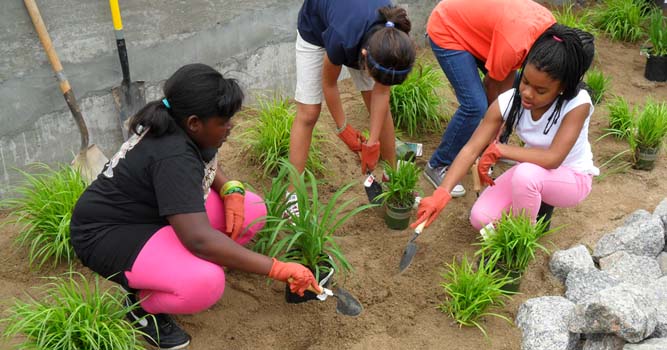
Rainscaping
Why Rainscape?
Rainscapes are landscape enhancements that reduce stormwater runoff from properties. WRRI invites you to install rainscapes to help improve your local waterway while enhancing your property. Check with your municipality’s stormwater staff, or your county’s Soil & Water Conservation District and Cooperative Extension staff for local assistance.
Most rain that falls on hard surfaces like roofs, driveways, roads, and parking lots flows directly to local waterways. These high flows carry pollutants, cause flooding, erode streambanks and disturb habitat. In contrast rainfall on natural surfaces like forests and meadows soaks into the ground, replenishing groundwater and streams. Rainscapes simulate natural drainage to intercept, capture and absorb rain into the ground.
Rainscaping helps to reduce: stormwater runoff from properties, drainage problems, pollution entering streams, water use during dry spells, water bills, mowing, fertilizer and pesticide use, and home heating and cooling costs. It helps to enhance aesthetics, bird and wildlife habitat and property values.
Factsheets
- 1.0 Know your rainscape
- 2.0 Disconnect downspouts
- 3.0 Collect rainwater
- 4.0 Naturalize with conservation plantings
- 5.0 Garden with the rain
- 5.1 Size a rain garden
- 5.2 Design a rain garden
- 5.3 Construct a rain garden
- 5.4 Plant a rain garden
- Rainscapes-All in one (26 pp)
Ways to Rainscape




Rain Gardens
What is it?
A rain garden is a depression in the ground that captures runoff from your roof or driveway and allows it to filter into the ground. The plants, mulch and soil in a rain garden combine natural processes to break down pollutants. Raingardens can be designed to look natural or manicured based on the landowner’s aesthetic goals, and can be planted in sun or shady areas.
Plants chosen for a raingarden must be drought tolerant and able to have wet roots for up to 3 days. Raingardens can stabilize soil, reduce localized flooding and drainage problems, and provide habitat for birds, butterflies and other wildlife. Raingardens can also be grassed depressions, but without additional plants they will absorb less rainfall and will not provide wildlife habitat.
How to install?
Installation requires identifying a location away from the foundation and in a rainwater flow path, assessing soil drainage to insure that water will drain in 3 days, sizing and designing the raingarden, digging and amending the soil, installing plants, and applying mulch. Plants will need regular watering until established, and during times of extreme drought. Raingarden maintenance is very similar to maintaining any landscaped area-pruning and replacing plants, weeding, and replacing mulch annually.
Raingardens should not be placed downhill from bare or eroded soils, or where future digging may occur- to avoid clogging them with soil.
What if my soil doesn’t drain?
Raingardens only work if water infiltrates within 3 days. If water ponds, another option is to create a small “pocket” wetland. Wetlands stay wet most of the time, and require plants that thrive in wet environments. A mix of vegetation provides habitat for insects and amphibians that prey on mosquito larvae.
Dispersing Runoff from Downspouts
What is it?
A downspout is a vertical pipe used to drain rainwater away from buildings to protect foundations. They are usually directed onto a driveway, or into a pipe or ditch that flows to a creek. Disconnecting the downspout flow from this system keeps rainfall on-site to spread over grass, landscaping, or into a wooded area.
How to install?
The procedure for disconnecting the downspout will vary depending on where you want to direct the water. If the runoff from your roof flows directly onto pavement, consider using downspout extenders to direct the water to a grassed, wooded, or landscaped area. Runoff collected in a rain barrel or cistern can reduce your water bill. Dispersing from a downspout may involve cutting the downspout; attaching elbows, extensions, and splashblocks to direct the water flow away from the house or into a rainbarrel. There is very little maintenance involved afterwards.
Rainbarrels and Cisterns
What is it?
A rainwater harvesting system, including small rainbarrels and larger cisterns, captures stormwater runoff from a roof and stores the water for later use. A rainwater harvesting system can be used to wash cars, outdoor furniture, or water gardens—even when water restrictions prevent the use of municipal water for those purposes. Because a rainwater harvesting system reduces potable water bills, the system can pay for itself over time. The chlorine-free rainwater also contains nutrients, such as nitrogen and phosphorus, that can help plants grow when it is used for irrigation. By using rainwater for purposes that don’t require treated drinking water, we reduce the demand on municipal water supplies and increase the sustainability of drinking water supplies.
How to install?
The roof must have at a gutter and a downspout to direct rain to the rainbarrel. Installation requires determining the size of the barrel, setting up the barrel on a level, solid surface, and modifying the downspout to direct water into the barrel. An overflow tube is directed away from the house. Rainbarrels must be used regularly to have an impact on your water bill and the environment. To maintain rain barrels, clean gutters of debris regularly, clean the debris off the screen on the top of the rainbarrel, and clean the barrel out annually after spring pollen season. Never drink water from a rainbarrel.
Conservation and Tree Planting
What is it?
Conservation plantings use native and/or drought tolerant plants that are adapted to local rainfall and soil conditions to replace part of your traditional lawn. When established, conservation plantings need much less maintenance than a lawn, though weeding, pruning, and mulching will help keep it looking attractive.
Grading and heavy machinery used during development usually removes topsoil and compacts our region’s clay soils. Resulting lawns absorb very little rain compared to undisturbed natural areas. Reducing lawn area by planting native shrubs, trees, and flowers provides multiple benefits such as reduced stormwater runoff, improved habitat for birds and other wildlife, and reduced costs for watering, fertilizing, and mowing lawns. Trees lower temperatures through shade and evapotranspiration, which reduces energy needs and costs, as well as raising the value of homes and attracting businesses and tourism. Urban trees reduce the “heat island effect,” cooling our cities by as much as 9 degrees. Trees remove harmful gases that contribute to smog, acid rain, and the greenhouse effect.
How to install?
Amend the soil to break up clay, incorporate organic material, plant native plants that are suitable for the location, cover bare areas with mulch, and maintain the area to meet your own landscaping goals. Even native plants and trees need watering immediately and for several few weeks after planting, but once established will not need watering. Watering trees during low rain times for two years after planning will help long term survival. Conservation areas can be actively managed for a manicured look, or left to grow like a natural area. You may want to check your homeowner’s association guidelines to learn what landscaping styles are accepted in your neighborhood, or to seek approvals if necessary.[/hide-this-part]
